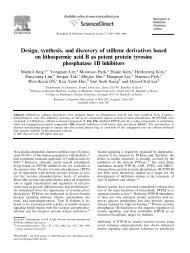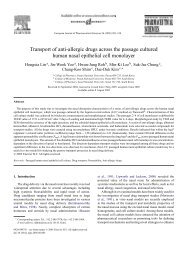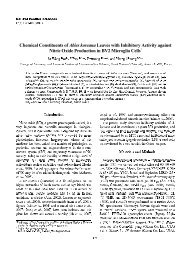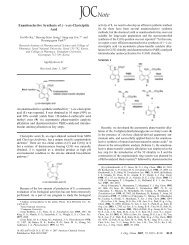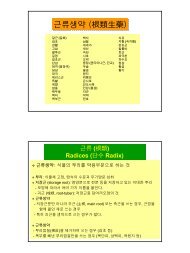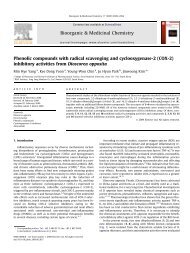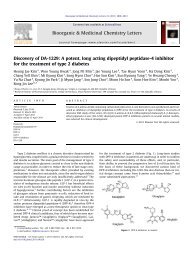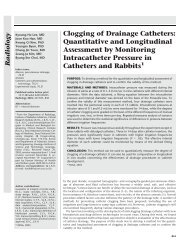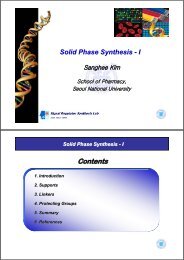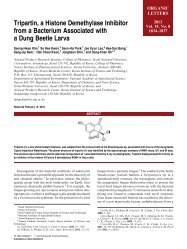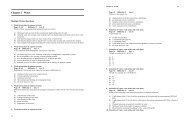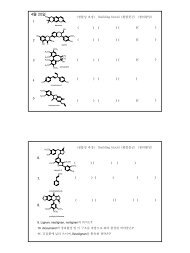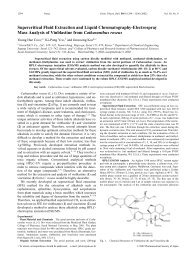Lecture-Protecting Groups for Organic Synthesis
Lecture-Protecting Groups for Organic Synthesis
Lecture-Protecting Groups for Organic Synthesis
You also want an ePaper? Increase the reach of your titles
YUMPU automatically turns print PDFs into web optimized ePapers that Google loves.
<strong>Protecting</strong> <strong>Groups</strong> <strong>for</strong><br />
<strong>Organic</strong> <strong>Synthesis</strong><br />
Sanghee Kim<br />
School of Pharmacy,<br />
Seoul National University<br />
<strong>Protecting</strong> <strong>Groups</strong> <strong>for</strong> <strong>Organic</strong> <strong>Synthesis</strong><br />
General References:<br />
– Kocienski, P. J. <strong>Protecting</strong> <strong>Groups</strong>, 3rd ed.; Georg<br />
Thieme Verlag: New York, 2005.<br />
– Greene, T. W.; Wuts, P. G. M. Protective <strong>Groups</strong> In<br />
<strong>Organic</strong> <strong>Synthesis</strong>, 3rd ed.; John Wiley & Sons: New<br />
York, 1991.<br />
1
<strong>Protecting</strong> <strong>Groups</strong> <strong>for</strong> <strong>Organic</strong> <strong>Synthesis</strong><br />
Contents:<br />
• Protection of<br />
1. Hydroxyl groups<br />
2. Ketones and aldehydes<br />
3. Amines<br />
4. Carboxylic Acids<br />
5. Alkynes<br />
<strong>Protecting</strong> <strong>Groups</strong> <strong>for</strong> <strong>Organic</strong> <strong>Synthesis</strong><br />
<strong>Protecting</strong> groups ?<br />
– Protect functional groups which may be incompatible with a set<br />
of reaction conditions<br />
– 2 step process : introduction & removal must be efficient<br />
– Selectivity<br />
• selective protection<br />
• selective deprotection<br />
When one protective group is stable to conditions that cleave<br />
another and the converse is also true, these groups are often said<br />
to be to bear an orthogonal relationship.<br />
2
Acetals<br />
Hydroxyl <strong>Protecting</strong> <strong>Groups</strong><br />
Acetals<br />
Hydroxyl <strong>Protecting</strong> <strong>Groups</strong><br />
3
Acetals<br />
Hydroxyl <strong>Protecting</strong> <strong>Groups</strong><br />
Acetals<br />
Hydroxyl <strong>Protecting</strong> <strong>Groups</strong><br />
4
Acetals<br />
Hydroxyl <strong>Protecting</strong> <strong>Groups</strong><br />
Acetals<br />
Hydroxyl <strong>Protecting</strong> <strong>Groups</strong><br />
5
Ethers<br />
Hydroxyl <strong>Protecting</strong> <strong>Groups</strong><br />
Ethers<br />
Hydroxyl <strong>Protecting</strong> <strong>Groups</strong><br />
6
Ethers<br />
Hydroxyl <strong>Protecting</strong> <strong>Groups</strong><br />
Ethers<br />
Hydroxyl <strong>Protecting</strong> <strong>Groups</strong><br />
7
Ethers<br />
Hydroxyl <strong>Protecting</strong> <strong>Groups</strong><br />
Silyl Ethers<br />
Hydroxyl <strong>Protecting</strong> <strong>Groups</strong><br />
8
Silyl Ethers<br />
Hydroxyl <strong>Protecting</strong> <strong>Groups</strong><br />
Silyl Ethers<br />
Hydroxyl <strong>Protecting</strong> <strong>Groups</strong><br />
9
Silyl Ethers<br />
Hydroxyl <strong>Protecting</strong> <strong>Groups</strong><br />
Silyl groups are typically deprotected with a source of<br />
fluoride ion.<br />
The Si–F bond strength is about 30 kcal/mol stronger than<br />
the Si–O bond.<br />
Hydroxyl <strong>Protecting</strong> <strong>Groups</strong><br />
Silyl Ethers<br />
10
Silyl Ethers<br />
Hydroxyl <strong>Protecting</strong> <strong>Groups</strong><br />
Silyl Ethers<br />
Hydroxyl <strong>Protecting</strong> <strong>Groups</strong><br />
11
Esters<br />
& Carbonates<br />
Hydroxyl <strong>Protecting</strong> <strong>Groups</strong><br />
Hydroxyl <strong>Protecting</strong> <strong>Groups</strong><br />
Esters & Carbonates<br />
12
Esters<br />
Hydroxyl <strong>Protecting</strong> <strong>Groups</strong><br />
In general, the susceptibility of esters to base catalyzed<br />
hydrolysis increases with the acidity of the product acid.<br />
Esters<br />
Hydroxyl <strong>Protecting</strong> <strong>Groups</strong><br />
13
Esters<br />
Hydroxyl <strong>Protecting</strong> <strong>Groups</strong><br />
Esters<br />
Hydroxyl <strong>Protecting</strong> <strong>Groups</strong><br />
14
Carbonates<br />
Hydroxyl <strong>Protecting</strong> <strong>Groups</strong><br />
Carbonates<br />
Hydroxyl <strong>Protecting</strong> <strong>Groups</strong><br />
15
Carbonates<br />
Hydroxyl <strong>Protecting</strong> <strong>Groups</strong><br />
Hydroxyl <strong>Protecting</strong> <strong>Groups</strong><br />
Phenolic protective groups<br />
16
1,2 and 1,3-diols<br />
Hydroxyl <strong>Protecting</strong> <strong>Groups</strong><br />
1,2 and 1,3-diols<br />
Hydroxyl <strong>Protecting</strong> <strong>Groups</strong><br />
17
1,2 and 1,3-diols<br />
Hydroxyl <strong>Protecting</strong> <strong>Groups</strong><br />
1,2 and 1,3-diols<br />
Hydroxyl <strong>Protecting</strong> <strong>Groups</strong><br />
Selective protection of polyols:<br />
18
1,2 and 1,3-diols<br />
Hydroxyl <strong>Protecting</strong> <strong>Groups</strong><br />
Selective protection of polyols:<br />
1,2 and 1,3-diols<br />
Hydroxyl <strong>Protecting</strong> <strong>Groups</strong><br />
Selective protection of polyols:<br />
19
1,2 and 1,3-diols<br />
Hydroxyl <strong>Protecting</strong> <strong>Groups</strong><br />
1,2 and 1,3-diols<br />
Hydroxyl <strong>Protecting</strong> <strong>Groups</strong><br />
20
1,2 and 1,3-diols<br />
Hydroxyl <strong>Protecting</strong> <strong>Groups</strong><br />
1,2 and 1,3-diols<br />
Hydroxyl <strong>Protecting</strong> <strong>Groups</strong><br />
21
1,2 and 1,3-diols<br />
Hydroxyl <strong>Protecting</strong> <strong>Groups</strong><br />
1,2 and 1,3-diols<br />
Hydroxyl <strong>Protecting</strong> <strong>Groups</strong><br />
22
Carbonyl <strong>Protecting</strong> <strong>Groups</strong><br />
Carbonyl <strong>Protecting</strong> <strong>Groups</strong><br />
23
Carbonyl <strong>Protecting</strong> <strong>Groups</strong><br />
Carbonyl <strong>Protecting</strong> <strong>Groups</strong><br />
24
Carbonyl <strong>Protecting</strong> <strong>Groups</strong><br />
Carbonyl <strong>Protecting</strong> <strong>Groups</strong><br />
25
Carbonyl <strong>Protecting</strong> <strong>Groups</strong><br />
Carbonyl <strong>Protecting</strong> <strong>Groups</strong><br />
A variety of methods has been developed <strong>for</strong> the cleavage of S,S''-<br />
dialkyl acetals, largely due to the fact that these functional groups are<br />
often difficult to remove.<br />
26
Carbonyl <strong>Protecting</strong> <strong>Groups</strong><br />
Esters <strong>for</strong> acid<br />
Carbonyl <strong>Protecting</strong> <strong>Groups</strong><br />
27
Esters <strong>for</strong> acid<br />
Carbonyl <strong>Protecting</strong> <strong>Groups</strong><br />
Esters <strong>for</strong> acid<br />
Carbonyl <strong>Protecting</strong> <strong>Groups</strong><br />
28
Esters <strong>for</strong> acid<br />
Carbonyl <strong>Protecting</strong> <strong>Groups</strong><br />
Esters <strong>for</strong> acid<br />
Carbonyl <strong>Protecting</strong> <strong>Groups</strong><br />
29
Amine <strong>Protecting</strong> <strong>Groups</strong><br />
General <strong>Protecting</strong> <strong>Groups</strong><br />
Amine <strong>Protecting</strong> <strong>Groups</strong><br />
General preparation<br />
Bases that are typically employed are tertiary amines or aqueous hydroxide.<br />
30
Carbamates<br />
Amine <strong>Protecting</strong> <strong>Groups</strong><br />
Carbamates<br />
Amine <strong>Protecting</strong> <strong>Groups</strong><br />
31
Carbamates<br />
Amine <strong>Protecting</strong> <strong>Groups</strong><br />
Carbamates<br />
Amine <strong>Protecting</strong> <strong>Groups</strong><br />
32
Amides<br />
Amine <strong>Protecting</strong> <strong>Groups</strong><br />
Sulfonamides<br />
Amine <strong>Protecting</strong> <strong>Groups</strong><br />
33
Sulfonamides<br />
Amine <strong>Protecting</strong> <strong>Groups</strong><br />
Alkyne <strong>Protecting</strong> <strong>Groups</strong><br />
• Typical silyl groups include TMS, TES, TBS, TIPS, and TBDMS.<br />
• Many silyl acetylenes are commercially available, and are useful acetylene<br />
equivalents.<br />
34
Alkyne <strong>Protecting</strong> <strong>Groups</strong><br />
Silyl chorides are suitable <strong>for</strong> smaller silyl groups, but the preparation of more<br />
hindered silyl acetylenes may require the use of the more reactive silyl triflate.<br />
Alkyne <strong>Protecting</strong> <strong>Groups</strong><br />
35
Alkyne <strong>Protecting</strong> <strong>Groups</strong><br />
Unpublished result of S. Kim<br />
36



